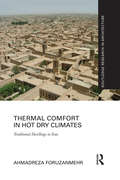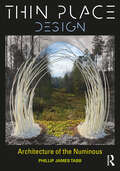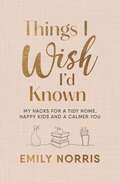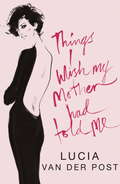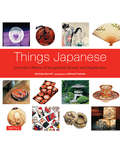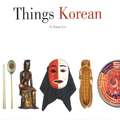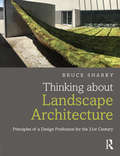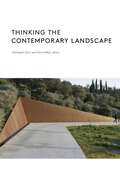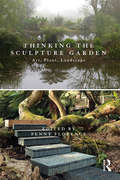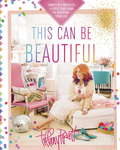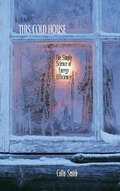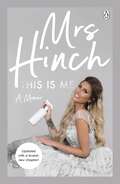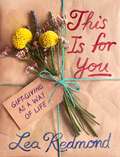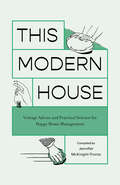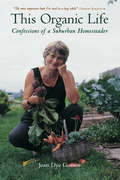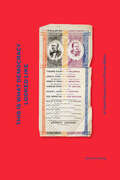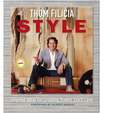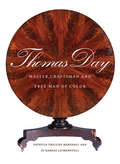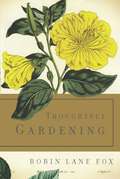- Table View
- List View
Thermal Comfort in Hot Dry Climates: Traditional Dwellings in Iran (Routledge Research in Architecture)
by Ahmadreza ForuzanmehrWith increases in global temperatures, the risk of overheating is expected to rise around the world. This results in a much higher dependency upon energy-intensive cooling systems and air-conditioners to provide thermal comfort, but how sustainable is this in a world where problems with the production of electricity are predicted? Vernacular houses in hot and dry central Iran have been adapted to the climate through passive cooling techniques, and this book provides a valuable assessment of the thermal performance of such housing. Shedding new light on the ability of traditional housing forms to provide thermal comfort, Thermal Comfort in Hot Dry Climates identifies the main cooling systems and methods in traditional houses in central Iran, and examines how architectural elements such as central courtyards, distinct seasonal rooms, loggias, basements and wind-catchers can contribute to the provision of thermal comfort in vernacular houses.
Thermoelectric Micro / Nano Generators, Volume 1: Fundamental Physics, Materials and Measurements
by Takao Mori Hiroyuki Akinaga Atsuko Kosuga Gustavo ArdilaThis book explores a key technology regarding the importance of connections via an Internet of Things network and how this helps us to easily communicate with others and gather information. Namely, what would happen if this suddenly became unavailable due to a shortage of power or electricity? Using thermoelectric generators is a viable solution as they use the heat around us to generate the much-needed electricity for our technological needs. This first volume explores the computational and data-driven development of these thermoelectric generators, as well as the use of various abundant materials such as copper and silver chalcogenides and nanocarbons. It also offers reviews on universal property enhancement principles and the case of strongly correlated oxides, and goes on to explore the metrology of the thermal properties of thermoelectric generators, detailing methods of how to measure the absolute Seebeck coefficient using the Thomson effect and the thermal diffusivity of thin films using the ultrafast laser flash method.
Thermoelectric Micro / Nano Generators, Volume 2: Challenges and Prospects
by Takao Mori Hiroyuki Akinaga Atsuko Kosuga Gustavo ArdilaThis book explores a key technology regarding the importance of connections via an Internet of Things network and how this helps us to easily communicate with others and gather information. Namely, what would happen if this suddenly became unavailable due to a shortage of power or electricity? Using thermoelectric generators is a viable solution as they use the heat around us to generate the much-needed electricity for our technological needs. This second volume on the challenges and prospects of thermoelectric generators covers the reliability and durability of thermoelectric materials and devices, the effect of microstructures on the understanding of electronic properties of complex materials, thermoelectric nanowires, the impact of chemical doping or magnetism, thermoelectric generation using the anomalous Nernst effect, phonon engineering, the current state and future prospects of thermoelectric technologies, transition metal silicides, and past, present and future applications of thermoelectrics.
Thin Place Design: Architecture of the Numinous
by Phillip James TabbWhat makes the places we inhabit extraordinary? Why are some urban spaces more vital and restorative? Wonderful landscapes, inspiring works of architecture and urban design, and the numinous experiences that accompany them have been an integral dimension of our culture. Up-lifting spaces, dramatic use of natural light, harmonic proportional geometry, magical landscapes, historic sites and vital city centers create special, even sacred moments in architecture and planning. This quality of experience is often seen as an aesthetic purpose intended to inspire, ennoble, ensoul and spiritually renew. Architecture and urban spaces, functioning in this way, are considered to be thin places.
Things I Wish I’d Known: My hacks for a tidy home, happy kids and a calmer you
by Emily Norris'Queen of the mothering hack. Emily Norris delivers ingenious ideas to make life a little bit easier!’ – Giovanna Fletcher, bestselling author and podcaster'Genius hacks to save time and bring a little more joy' – Anna Mathur, Psychotherapist and bestselling author'Packed with tips and ideas that make mum life *just* a little easier!' – Harriet Shearsmith, @tobyandrooI became obsessed with mum hacks when a friend showed me a game-changing tip during my baby days - that baby vests can be pulled down (not up) in the event of an explosive poo. I couldn't believe I had been a mum for so long and not known! Things I Wish I'd Known will bring you hundreds of quick and clever solutions, just like this, all to make the parenting juggle easier.You'll find my favourite hacks and habits, as well as dozens of new ones, all designed to give your day-to-day a lift. From cleaning hacks that leave your home sparkling in no time, laundry tricks that save you money, and simple tweaks to night-time routines which transform everyone's sleep, I'll show you how to hack every aspect of home-life so you feel less stress and more joy!Emily x
Things I Wish My Mother Had Told Me: Lessons in Grace and Elegance
by Lucia Van Der PostPacked full of golden rules from one of Britain's most stylish women, Things I Wish My Mother Had Told Me is a woman's companion for life. Lucia van der Post reveals the secrets of dressing stylishly with advice on everything from how to organise your wardrobe, what to wear to travel and where to buy delicious underwear, great cashmere and sassy skirts. Practical health and beauty tips will help you to choose a sophisticated scent, get fitter and decide whether cosmetic surgery is for you.Once you've mastered looking fantastic, learn how to add some elegance to other areas of your life. Discover great shortcuts to entertaining your guests as well as suggestions, from designers around the world, on how to make your home match the elegant new you. With advice on relationships, motherhood and how to juggle work, love and children, this is the essential handbook for women of all ages. Whether you are just starting out in life or want to age gracefully and make 60 the new 40, let Lucia van der Post guide you towards a new life and a new you with a touch of style.
Things Japanese
by Michael Freeman Nicholas BornoffBeautifully crafted samurai swords; exquisitely carved netsuke toggles; elegant wooden tansu chests; elaborate tea ceremony implements; fabulously expensive silk-and-gold embroidered kimonos. All of these highly recognizable Japanese objects are imbued with a sense of history and artistry, as well as a unique Japanese aesthetic sense that easily reaches across cultural boundaries. In Things Japanese: Everyday Objects of Extraordinary Beauty and Significance, author Nicholas Bornoff and photographer Michael Freeman examine over 60 traditional objects that are definitively, uniquely Japanese, demonstrating their significance and relevance for a modern Western audience.In this delightful book, each object is shown and described in loving detail-placed within its broader historical and cultural context as an everyday item used by real people in traditional Japan. Each item is listed under its Japanese and English name-and illustrated in glorious, full-color photographs to highlight its great artistry and craftsmanship. Things Japanese is the perfect book for the antique lover in your life, or anyone interested in the art, culture and history of Japan.
Things Japanese
by Nicholas BornoffBeautifully crafted samurai swords; exquisitely carved netsuke toggles; elegant wooden tansu chests; elaborate tea ceremony implements; fabulously expensive silk-and-gold embroidered kimonos. All of these highly recognizable Japanese objects are imbued with a sense of history and artistry, as well as a unique Japanese aesthetic sense that easily reaches across cultural boundaries. In Things Japanese: Everyday Objects of Extraordinary Beauty and Significance, author Nicholas Bornoff and photographer Michael Freeman examine over 60 traditional objects that are definitively, uniquely Japanese, demonstrating their significance and relevance for a modern Western audience. In this delightful book, each object is shown and described in loving detail-placed within its broader historical and cultural context as an everyday item used by real people in traditional Japan. Each item is listed under its Japanese and English name-and illustrated in glorious, full-color photographs to highlight its great artistry and craftsmanship. Things Japanese is the perfect book for the antique lover in your life, or anyone interested in the art, culture and history of Japan.
Things Korean
by O-Young Lee John HolsteinThings Korean is a useful guide to traditional life in Korea, presented in an accessible and attractive format. O-Young Lee, former Korean Minister of Culture gives us a survey of native objects from Korea, from totems(Changsung) to hair-pins(binyo), crock pots(Changdokdae) to temple bells(Jong), scissors(Kawi) to graves(mudon) explaining their significance and place in everyday Korean life.Each item in the book is listed under its English and Korean name; a glossary is provided to further assist the reader. Lavishly illustrated with more than 100 color illustrations, Things Korean is a magnificent celebration of Korean culture.
Thinking Color in Space: Positions, Projects, Potentials
by Kerstin Schultz Hedwig Wiedemann-Tokarz Eva Maria HerrmannThe interaction between color and architecture determines our perception of space, and defines the tectonic relationships. In their book Thinking Color in Space: Positions, Projects, Potentials, authors Kerstin Schultz, Hedwig Wiedemann-Tokarz, and Eva Maria Herrmann explore the fascinating spatial potential of color. <p><p> The multi-layered dimensions of interpretation in the experience of color are design and communication means which, however, are often not fully used—color oscillates between autonomy and functional purpose, and should be understood as a distinct material that can be used as part of the design. Thinking Color in Space: Positions, Projects, Potentials focuses both on the tangible aspects and design criteria of color, and on its indeterminate nature and its experience value. Using examples in art and architecture, the spatial interdependency of color is illustrated, as is its interaction with structure, light, and geometry.
Thinking about Landscape Architecture: Principles of a Design Profession for the 21st Century
by Bruce SharkyWhat is landscape architecture? Is it gardening, or science, or art? In this book, Bruce Sharky provides a complete overview of the discipline to provide those that are new to the subject with the foundations for future study and practice. The many varieties of landscape practice are discussed with an emphasis on the significant contributions that landscape architects have made across the world in daily practice.? Written by a leading scholar and practitioner, this book outlines the subject and explores how, from a basis in garden design, it 'leapt over the garden wall' to encapsulate areas such as urban and park design, community and regional planning, habitat restoration, green infrastructure and sustainable design, and site engineering and implementation. Coverage includes: The effects that natural and human factors have upon design, and how the discipline is uniquely placed to address these challenges? Examples of contemporary landscape architecture work - from storm water management and walkable cities to well-known projects like the New York High Line and the London Olympic Park? Exploration of how art and design, science, horticulture, and construction come together in one subject? Thinking about Landscape Architecture is perfect for those wanting to better understand this fascinating subject, and those starting out as landscape architecture students.
Thinking the Contemporary Landscape
by Dora Imhof Christophe GirotOn the heels of our groundbreaking books in landscape architecture, James Corner's Recovering Landscape and Charles Waldheim's Landscape Urbanism Reader, comes another essential reader, . Examining our shifting perceptions of nature and place in the context of environmental challenges and how these affect urbanism and architecture, the seventeen essayists in argue for an all-encompassing view of landscape that integrates the scientific, intellectual, aesthetic, and mythic into a new multidisciplinary understanding of the contemporary landscape. A must-read for anyone concerned about the changing nature of our landscape in a time of climate crisis.
Thinking the Sculpture Garden: Art, Plant, Landscape
by Penny FlorenceThis innovative book poses two, deceptively simple, questions: what is a sculpture garden, and what happens when you give equal weight to the main elements of landscape, planting and artwork? Its wide-ranging frame of reference, including the USA, Europe and Japan, is brought into focus through Tremenheere Sculpture Garden, Cornwall, with which the book begins and ends. Effectively less than 15 years old, and largely the work of one man, Tremenheere affords an opportunity to examine as work-in-progress the creation of a new kind of sculpture garden. Including a historical overview, the book traverses multiple ways of seeing and experiencing sculpture gardens, culminating in an exploration of their relevance as 'cultural ecology' in the context of globalisation, urbanisation and climate change. The thinking here is non-dualist and broadly aligned with New Materialisms and Material Feminisms to explore our place as humans in the non-human world on which we depend. Eminent contributors, including John Dixon Hunt, George Descombes, Bernard Lassus and David Leatherbarrow, approach these issues through practices and theories of landscape architecture; garden and art making; history and writing; and philosophy. Richly illustrated with over 100 images, including a colour plate section, the book will primarily appeal to those engaged in professional or academic research, along with sculpture garden visitors, who will find new and surprising ways of experiencing plants and art in natural and urban settings.
This Can Be Beautiful: Simple DIY Projects to Style Your Home and Redesign Your Life
by Tiffany PrattA visual and creative feast for anyone who wants to imagine and build a more beautiful life.Stylist, designer, HGTV star and fairy godmother of glitter, Tiffany Pratt looks at the world as a blank canvas. With every choice she is presented or every decision she makes, she does it with one mantra in mind: that this--whatever "this" is--can be beautiful. Whether it's sprucing up some old wallpaper, rejuvenating your bedsheets, turning an accidental bleach stain into a multicolored sensation, or even hosting a party and re-thinking how you make lootbags, Tiffany's creative energy is fantastically contagious. In her much anticipated debut, Tiffany brings her vivacious attitude directly to readers, crafters, designers and DIY-ers. She'll guide you through over 45 creative and straightforward projects that will beautify your home, wardrobe, beauty routine, travel style and more. Whatever your taste, crafting skill, budget, or time, you'll find a project that inspires you to make Tiffany's visions your own. Break out the glitter, paintbrushes and colored duct tape! Let Tiffany empower you to create the styled life you want using what you already have. All it takes is a little effort, some love, and a bit of hot glue.
This Cold House: The Simple Science of Energy Efficiency
by Colin SmithA “witty, erudite, and accessible” guide to creating an environmentally friendly home without sacrificing comfort (Jeffrey C. May, author of My House Is Killing Me!).Does turning the thermostat down on a winter’s night offset the costs of reheating the house in the morning? What will best prevent energy loss: new windows or insulation in the attic? Is heating oil cheaper than natural gas?In This Cold House, Colin Smith blends science with anecdote and example to help homeowners identify heating and cooling priorities and choose the most appropriate methods, tools, and equipment. Basic equations allow you to estimate possible savings in annual heating and cooling bills and determine payback times for improvement projects.Practical and entertaining, This Cold House illuminates the concepts behind energy efficiency and translates them into ideas you can use, whether you live in a castle, igloo, or house.“Packs in important insights and is a pick for any general interest lending library catering to homeowners and those concerned with energy savings and the environment.” —Midwest Book Review“Smith . . . has a wonderful way with words, and his storytelling is superb. This guy sure knows how to hang an analogy on a scientific principle to make it delightfully understandable.” —Dan Holohan, heatinghelp.com
This Is Me: The No 1 Sunday Times Bestseller
by Mrs HinchGet to know the woman behind the Instagram cleaning sensation, Mrs Hinch, in her fascinating and remarkably honest memoir*** FEATURING A BONUS CHAPTER ABOUT THE BIRTH OF LENNIE ***THE SUNDAY TIMES NO. 1 BESTSELLER'Gut-wrenchingly honest' The Mail on Sunday'I love that woman so much, she is just so great' Rylan Clark-Neal, BBC Radio 2_____________I sometimes can't believe just how much has happened in the last couple of life-changing years. It's been a total whirlwind of a journey, and I'm so grateful to all my followers for their amazing love and support along the way.From my very first toy kitchen which was my pride and joy right through to the my very first Instagram posts stories of my cleaning routine, I'm going to take you back to the start of how it all began. But there is so much more to my story than just cleaning tips; there have been the highest of highs, but also heart-breaking devastating lows.So let's do this! Put your Hinch Lists to one side, get comfy and join me on the sofa with a cuppa. Welcome to my world.This is me: Soph - the wife, the mother and the person behind Mrs Hinch._____________'The sensation' Sun'We're mad about Mrs Hinch' Vogue'My new cleaning goddess' Daily Telegraph'Doing for household chores what Marie Kondo did for tidying' Daily Mirror'Mrs Hinch offers a reassuring structure for the day, a vision of domestic order' Guardian
This Is for You: Gift-Giving as a Way of Life
by Lea RedmondThe essential guide for gift-giving that makes our dearest feel loved and offers deep and lasting connection—from the author of the bestselling Letters to My Baby and creator of the “Letters to . . .” seriesRiddled with obligation, expense, and waste, gifts are often reduced in our consumeristic culture to products for purchase. We all want to give good gifts—but how?In This Is for You, artist and bestselling author Lea Redmond casts a vision for gift-giving as you’ve never seen it before. At their best, she proposes, gift-giving and receiving are an opportunity to practice relational care at every scale for the wellbeing of people and planet.“Gifts are relationships in miniature,” Redmond writes—a way to honor the spaces between us and practice the best of our humanity. Beyond the usual gift guide, This Is for You is a manifesto on open-hearted living that can enrich our relationships and awaken us to the world and its inherent abundance.With inspired ideas and stories that sparkle, Redmond empowers you to be generous in your kinkeeping, courageous in your connection, and surprised by your own capacity for creativity.Whether you’re searching for a great gift for a birthday, holiday, anniversary, wedding, or “just because,” This Is for You offers:Practical prompts for composing gift ideas your loved ones will cherishTips for surprises, wrapping, and wish lists that workCreative ideas for keeping within your budget as well as no-cost gift ideasPractical guidance on how to respond to an unwanted giftThis Is for You is delightfully illustrated with the author’s line drawings throughout.
This Modern House: Vintage Advice and Practical Science for Happy Home Management
by Jennifer Mcknight-TrontzThe time-tested advice you never learned in school for getting back to basics and running a healthy, happy, sustainable household.In this amazing collection of proven wisdom and practical advice from real vintage textbooks, you&’ll find everything you need to know about shopping, cooking, cleaning, budgeting, and managing a household like an adult—whether you&’re renting your first apartment or establishing a family home.Learn handy home management skills such as:• Replacing a button• Planning a dinner party• Choosing paint colors• Reducing food waste• Making natural cleaning supplies• And many, many moreGive your household a happier, healthier future with time-tested tips from the past!Previously published in 2010 as Home Economics, this fully updated version includes a new introduction and improved advice on cooking and canning.
This Organic Life
by Joan Dye GussowJoan Dye Gussow is an extraordinarily ordinary woman. She lives in a home not unlike the average home in a neighborhood that is, more or less, typically suburban. What sets her apart from the rest of us is that she thinks more deeply--and in more eloquent detail--about food. In sharing her ponderings, she sets a delightful example for those of us who seek the healthiest, most pleasurable lifestyle within an environment determined to propel us in the opposite direction. Joan is a suburbanite with a green thumb, with a feisty, defiant spirit and a relentlessly positive outlook. At the heart of "This Organic Life" is the premise that locally grown food eaten in season makes sense economically, ecologically, and gastronomically. Transporting produce to New York from California--not to mention Central and South America, Australia, or Europe--consumes more energy in transit than it yields in calories. Add in the deleterious effects of agribusiness, such as the endless cycle of pesticide, herbicide, and chemical fertilizers; the loss of topsoil from erosion of over-tilled croplands; depleted aquifers and soil salinization from over-irrigation; and the arguments in favor of "this organic life" become overwhelmingly convincing. Joan's story is funny and fiery as she points out the absurdities we have unthinkingly come to accept. Joan has discovered ways to nourish herself, literally and spiritually, from her own backyard. If you are looking for a tale of courage and independence in a setting that is entirely familiar, read her story.
This is What Democracy Looked Like: A Visual History of the Printed Ballot
by Alicia ChengThis Is What Democracy Looked Like, the first illustrated history of printed ballot design, illuminates the noble but often flawed process at the heart of our democracy. An exploration and celebration of US ballots from the nineteenth and early twentieth centuries, this visual history reveals unregulated, outlandish, and, at times, absurd designs that reflect the explosive growth and changing face of the voting public. The ballots offer insight into a pivotal time in American history—a period of tectonic shifts in the electoral system—fraught with electoral fraud, disenfranchisement, scams, and skullduggery, as parties printed their own tickets and voters risked their lives going to the polls.
Thom Filicia Style
by Thom Filicia"I'm a democratic design snob. I see it as my mission to help stamp out boring, unimaginative interiors. But I also love people, having fun, and what I do for a living. I think a fabulously styled place is achievable by everyone. Think of me as your decorating wingman." Thom Filicia, whose one-of-a-kind makeover genius gained national attention through his starring roles on Queer Eye for the Straight Guy and Dress My Nest, offers the ultimate handbook for creating gorgeous interiors that showcase your unique personal style. Those who have witnessed Thom's remarkable makeovers on television already know about the much-anticipated reveal moment when the emotionally overwhelmed homeowners are struck speechless by the miracle he has created. The same miracle is now possible for your home, with the secrets and tips contained in Thom Filicia Style. With his trademark wit and friendly voice, Thom deconstructs how he works his magic and provides pages of invaluable advice, inspiration, before-and-after photos, case studies, floor plans, and product information. His approach will help you elevate your personal aesthetic by strategizing the best ways to make the most out of every space. From his work on a Manhattan loft to a suburban family home, Thom brings a fresh and invigorating vision to the way we live -- a vision that can apply to homes and decorating budgets of any size. Demystifying the decorating process one step at a time, Thom has filled this guide with everything you need to create the perfect interior. Thom Filicia Style is like having the designer himself on hand to take care of all the details.
Thomas Day: Master Craftsman and Free Man of Color
by Patricia Phillips Marshall Jo Ramsay LeimenstollThomas Day (1801-61), a free man of color from Milton, North Carolina, became the most successful cabinetmaker in North Carolina--white or black--during a time when most blacks were enslaved and free blacks were restricted in their movements and activities. His surviving furniture and architectural woodwork still represent the best of nineteenth-century craftsmanship and aesthetics. In this lavishly illustrated book, Patricia Phillips Marshall and Jo Ramsay Leimenstoll show how Day plotted a carefully charted course for success in antebellum southern society. Beginning in the 1820s, he produced fine furniture for leading white citizens and in the 1840s and '50s diversified his offerings to produce newel posts, stair brackets, and distinctive mantels for many of the same clients. As demand for his services increased, the technological improvements Day incorporated into his shop contributed to the complexity of his designs. Day's style, characterized by undulating shapes, fluid lines, and spiraling forms, melded his own unique motifs with popular design forms, resulting in a distinctive interpretation readily identified to his shop. The photographs in the book document furniture in public and private collections and architectural woodwork from private homes not previously associated with Day. The book provides information on more than 160 pieces of furniture and architectural woodwork that Day produced for 80 structures between 1835 and 1861. Through in-depth analysis and generous illustrations, including over 240 photographs (20 in full color) and architectural photography by Tim Buchman, Marshall and Leimenstoll provide a comprehensive perspective on and a new understanding of the powerful sense of aesthetics and design that mark Day's legacy.
Thomas Sheraton's Classical Revival Furniture Designs
by Thomas SheratonElegant 18th-century style book that was immediately successfully in England, Russia, America, British India. Complete coverage of Sheraton's most important designs: clock cases, commodes, drawing tables, library steps, chairs, other items. 98 plates.
Thoughtful Gardening
by Robin Lane FoxIn Thoughtful Gardening, award-winning historian and Financial Times gardening columnist Robin Lane Fox takes readers on a delightful journey through each season of the gardening year. From fending off vine-weevils to visiting Yves Saint Laurent’s private gardens in Marrakech, Fox imbues each of his musings with grace, sophistication, and charm. Essential reading for anyone planting a new garden or taking stock of one after several years, Thoughtful Gardening offers expert advice and a touching reminder of the power of art and literature to deepen what we see and experience in nature. Combining a vast understanding of horticulture with witty and stylish storytelling, these vignettes form--season by season--a rich reflection on the lessons, challenges, and joys of life with a green thumb.
